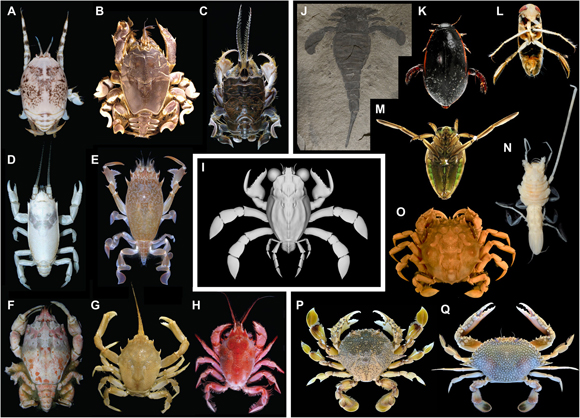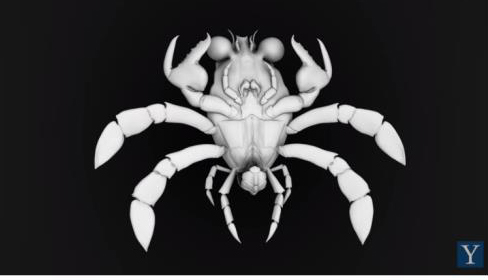New Study of Cretaceous Crabs Ruffles Feathers
Callichimaera perplexa et al Challenging the Definition of a Crab
An international team of scientists reported the discovery of a variety of Late Cretaceous marine crustacea that have challenged the current definitions of what makes a crab. It is a case of a Cretaceous crab ruffling a few scientific feathers.
Writing in the academic journal “Science Advances”, the researchers from the University of Alberta, Kent State University, the University of Montreal, the Smithsonian Tropical Research Institute in Panama, the Canadian Parks and Wilderness Society, the National Autonomous University of Mexico, the University of Nevada, and the College of Communication and Design in Boca Raton, Florida, as well as Yale University , describe the discovery of hundreds of beautifully-preserved specimens from the USA and Colombia.
A Life Reconstruction of the Cretaceous Crab Callichimaera perplexa
Picture credit: Elissa Martin, (Yale Peabody Museum of Natural History)
The preserved remains include hundreds of tiny shrimp fossils and an entirely new branch of the evolutionary tree for crabs (Order Decapoda).
A Very “Goofy-looking” Crab – Callichimaera perplexa
According to lead researcher, Yale University palaeontologist Javier Luque, the most significant fossil discovery is Callichimaera perplexa, which at around 95-million-years-old, is the earliest example of a swimming arthropod with paddle-like legs since the eurypterids (sea scorpions), that are believed to have died out in the Permian. The genus name derives from the mythical creature called a chimera, which was formed from the body parts of a variety of different animals. In a press release from Yale University, it is stated that the binomial scientific name translates as “perplexing beautiful chimera.”
Examining a Fossil Specimen (Callichimaera perplexa)
Picture credit: Yale University
A Unique and Very Strange Cretaceous Nektonic Crab
Measuring around 2-3 centimetres in diameter, Callichimaera is described as looking very strange with large, unprotected compound eyes with no sockets, bent claws, leg-like mouth parts, a long body and an exposed tail. It was nektonic (an active swimmer), as an adult it resembled typical crab larval stages. This suggests that some ancient crabs may have retained a few of their larval traits into adulthood, amplified them, and developed a new body architecture. This is an evolutionary process called “heterochrony” – a change to the timing or rate of development relative to the ancestor.
The Diverse Body Plans of Swimming Crabs and other Nektonic Arthropods
Picture credit: Yale University
Luque commented:
“Callichimaera perplexa is so unique and strange that it can be considered the platypus of the crab world. It hints at how novel forms evolve and become so disparate through time. Usually we think of crabs as big animals with broad carapaces, strong claws, small eyes in long eyestalks, and a small tail tucked under the body. Well, Callichimaera defies all of these ‘crabby’ features and forces a re-think of our definition of what makes a crab a crab.”
A Computer-generated Image Showing the Underside of Callichimaera perplexa
Picture credit: Yale University
The scientific paper: “Exceptional Preservation of mid-Cretaceous Marine Arthropods and the Evolution of Novel Forms via Heterochrony” by J. Luque1, R. M. Feldmann, O. Vernygora, C. E. Schweitzer, C. B. Cameron, K. A. Kerr, F. J. Vega, A. Duque, M. Strange, A. R. Palmer and C. Jaramillo published in the journal Science Advances.
Everything acknowledges the assistance of a press release from Yale University in the compilation of this article.
Visit the user-friendly, award-winning Everything Dinosaur website: Everything Dinosaur.





